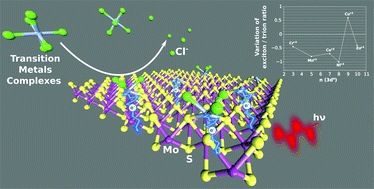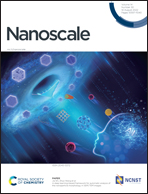3d transition metal coordination on monolayer MoS2: a facile doping method to functionalize surfaces†
Abstract
Two-dimensional materials (2DM) have attracted much interest due to their distinct optical, electronic, and catalytic properties. These properties can be tuned by a range of methods including substitutional doping and, as recently demonstrated, by surface functionalization with single atoms, thus increasing the 2DM portfolio. We theoretically and experimentally describe the coordination reaction between MoS2 monolayers and 3d transition metals (TMs), exploring their nature and MoS2–TM interactions. Density functional theory calculations, X-ray photoelectron spectroscopy (XPS), and photoluminescence (PL) spectroscopy point to the formation of MoS2–TM coordination complexes, where the adsorption energy for 3d TMs resembles the crystal-field (CF) stabilization energy for weak-field complexes. Pearson's theory for hard–soft acid–base and ligand-field theory were used to discuss the periodic trends of 3d TM coordination on MoS2 monolayer surfaces. We found that softer acids with higher ligand field stabilization energy, such as Ni2+, tend to form bonds with more covalent character with MoS2, which can be considered a soft base. On the other hand, harder acids, such as Cr3+, tend to form more ionic bonds. Additionally, we studied the trends in charge transfer and doping observed from XPS and PL results, where metals like Ni led to n-type doping. In contrast, Cu functionalization results in p-type doping. Therefore, the formation of coordination complexes on TMD's surface is a potentially effective way to control and understand the nature of single-atom functionalization of TMD monolayers without relying on or creating new defects.



 Please wait while we load your content...
Please wait while we load your content...